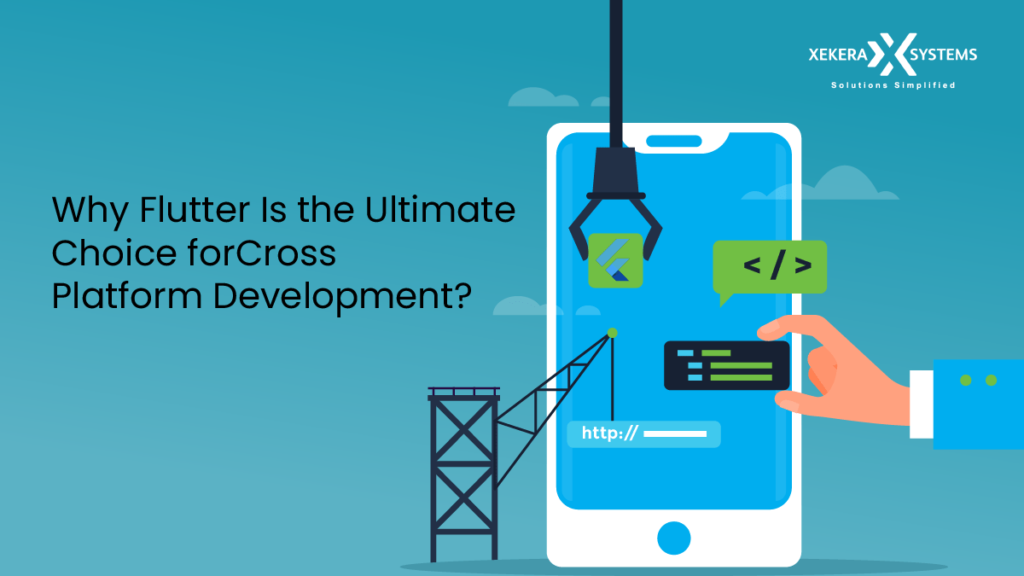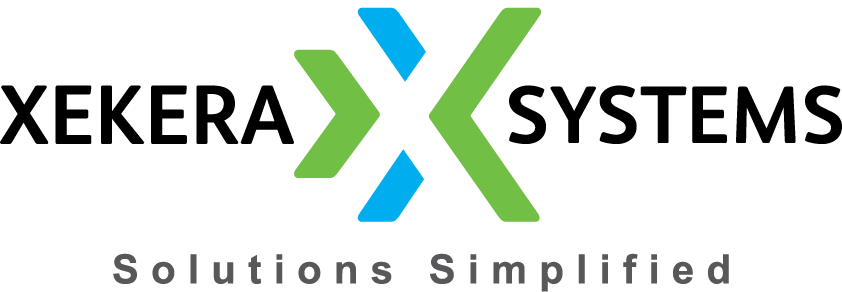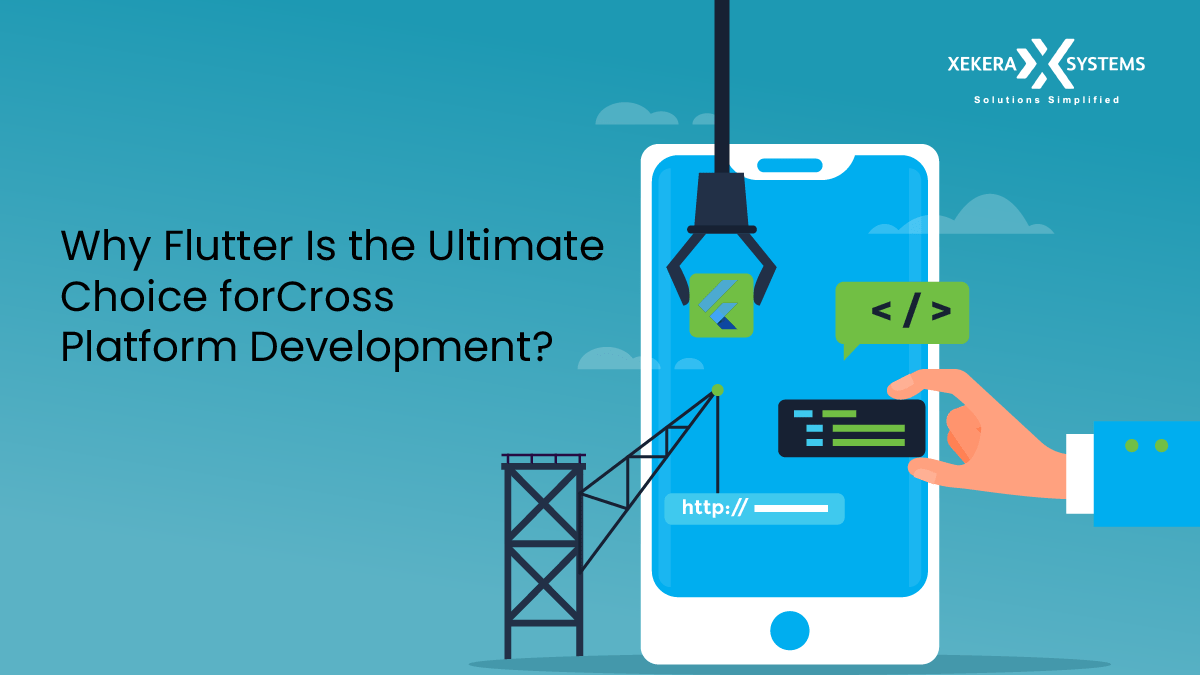Cross-platform development is one of the most sought-after frameworks today and is adopted by most businesses.
There are many such types of frames on the market that serve the same purpose!
Some of the most popular examples are Xamarin, PhoneGap, Ionic, Titanium, Monaca, Sencha, jQuery Mobile, React native, Flutter and many more. However, not every Cross Platform tool is equally effective.
Many of the above have vanished into thin air, but React native and Flutter still hold strong positions.
Did You know why?
Since the most trusted tech leaders Facebook and Google are behind it.
In this article, we will discuss the often discussed Google Flutter framework.
Wondering what flutter app development is? Or is Flutter good for app development?
You often search for questions like; Is flutter good for iOS? Or is flutter better than React native?
This article is about why flutter is a trusted solution for app development.
Let’s go ahead and dive deep into the article to know the inside of this best cross-platform tool.

What is cross-platform development and why should you use it?
A layman may ask, what is cross-platform?
Cross Platform Development basically means “killing two birds with one stone”
Confused?
Let me explain it simply.
Previously, when there were no cross-platform frameworks, developers had to write code for each platform (i.e. Android, iOS, Windows, and more) for the same application. So it became a tedious, costly and time-consuming affair for both the developers and the companies that invested in the development of this application.
Guess what Cross-platform could do?
Yes, you guessed it right! It made it possible to use one code for each mobile platform in less time and less money. Flutter has also made it possible to reduce the overall development time of applications.
Now let’s get to our topic and find out how flutter helps to build the best mobile app development and why it is the best choice if you want Cross Platform Development.
What is Flutter?
In short, flutter is a software development kit (SDK). It is rich in widgets, framework and tools that allow developers to create cross-platform applications seamlessly.
Why choose Flutter for cross-platform mobile development?
Before we get to the features, let’s take a look at the pros and cons of Flutter.
What are the benefits of flutter?
- It is completely free and open source
- Build your app faster
- Attractive User Interface (UI)
- Less coding
- Access to native functions
- Best for MVP (Minimum Viable Product)
- Older devices run on the same user interface
- Less testing effort
- Supporting the larger community
- Low maintenance requirements
- Built-in package manager from Dart
A few disadvantages of flutter:
- Flutter is limited to mobile devices only; Web browsers do not support Flutter
- Because the framework is new; there’s a chance you won’t find the feature you’re looking for.
- Flutter does not support apps for Apple Tv or Android Tv
- Less variety of packages compared to JS/TS
What are the features of Flutter?
As Google has now released its first major update, Flutter 1.2, it has focused on major areas such as;
- The latest developer tools for developing cross-platform apps
- The new version came with increased functionality of existing widgets
Improved stability, quality and performance of the core framework.
Native ARM (Advance RISC Machines) code.
Flutter has a feature called Native ARM, which is a useful feature for startups and tech businesses. It helps you realize your idea more easily and get maximum benefits from it for your upcoming projects.
Web-View component
These features will make it easier for users to view web content in mobile applications. In addition, Flutter makes it easy to navigate and stabilize apps.
Dart 2.2
Then the newly updated Dart.2.2 proved to be a game changer. Improved the performance of AOT compiled code.
In addition, the dart library offers a number of collection classes for modeling maps, lists, and sets of objects.
Let’s see what other features Dart2.2 provides:
- Maps are collections of key-value pairs.
- A list of flutters are ordered sequences of values where each value can be accessed by an index and can occur more than once
- All arrow language specifications are updated to reflect the changes
- Allows you to create new language functions with the Dart common interface (CFE)
In-app purchase
When a user initiates an app purchase in the app store, the feature allows the transaction to continue in your app.
Therefore, Google Play and App Store developers need to configure an app with in-app purchases to call their in-app purchase API.
Android App Bundles
Flutter Android app bundles provide all your app’s resources and compile code, but delay APK generation and Google Play submission.
No need to manually manage multiple APK files
These features allow the user to download smaller and optimized APK files. Not only users but developers also don’t need to create, sign and manage multiple APK files to support different devices.
Reduced APK file size
The split APK file mechanism used by Android app bundles helps reduce the size of apps and enables new features such as dynamic delivery of Android apps.
Dynamic functions module
This feature allows a developer to separate certain functions and resources from your application’s core module and add them to your application package.
For example, if your app includes a camera feature, you can make it a dynamic module. Later, when the user wants to download and install it, they can do it on demand.
Which Flutter tools help build a cross-platform mobile app?
This framework supports various tools like Android Studio and visual studio code. Other tools also allow the user to build applications from the command line and Dart DevTools for debugging.
In addition, it also allows developers to view logs, debug applications, and inspect widgets for Flutter application development.
Here are the flutter tools best suited for cross-platform application development.
Timeline View: Makes it easier for you to follow the application on a frame-by-frame level, familiar with rendering and computational work.
Widget inspector: These tools allow you to visualize and explore the tree hierarchy used by flutter for rendering.
Logging View: Displays a log of activity from your application, network, framework, and garbage collection events.
Source-level debugger: Allows the user to step through the code, mark breakpoints, and examine the call stack.
The best apps built with Flutter
Now you know the latest features incorporated in flutter. See which startups and established brands have entrusted it with Cross Platform development. Here are examples of flutter apps.
1. Alibaba (e-commerce)
I don’t think this e-commerce giant needs any introduction. Alibaba trusted Google Flutter to power parts of their app.
The app allows buyers to purchase products directly from manufacturers.
2. Google Ads (Utility application)
Well, the ultimate paid marketing app. This cross platform app is built with flutter to track the campaign set by the company. In addition, it allows Google experts to add/edit/remove a keyword and improve your campaign.
3. Birch Finance (Finance)
Birch Finance is essentially a credit card rewards app that helps users manage and optimize existing cards.
This financial application allows their user to know the expenses in all accounts and provide another way to earn and redeem rewards.
4. Tencent (Games and more)
The Chinese tech giant also relied on Flutter to provide software services for instant messaging and games such as Pub G, music, e-commerce and more.
5. Watermaniac (health and fitness)
The healthcare industry has also leaned towards cross-platform app development. Watermaniac decided to build his application in Flutter. The app allows its users to monitor the amount of water they consume.
How much does it cost to build a Flutter app?
Of course, building your app takes time and resources. Also; The more time spent on completing a project, the more time and resources will be used.
So both are proportional to the cost of developing your app.
If you are wondering how to start a flutter app, here is the app development cost calculation.
Cost Calculator:
Wondering how much it will cost to develop a Flutter app?
Total cost = number of hours required for the SDLC process * Fee per hour of resources required
Primarily; SDLC processes contain a detailed plan for how to build, test, deploy, change, and maintain that application. It includes UI/UX design, front-end, back-end development, quality assurance and manufacturing.
The most important is; If a small app with basic features is charging you between $12,000 and $60,000, Flutter will cost you half the price.
Conclusion
To summarize; Cross Platform Development has so much potential for startups and enterprises. In a nutshell; As the latest addition to the development framework, Flutter has so much to offer.
Therefore; if you want to build flutter apps, this is perfect for you if you want fast results. Whether you’re building a minimum viable product (MVP) or a full-fledged enterprise application, this is the answer.



